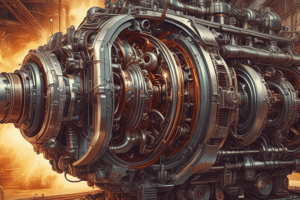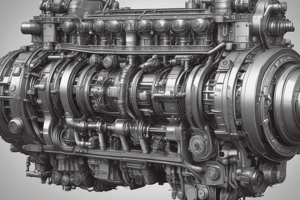Podcast
Questions and Answers
What is the primary role of the inlet manifold in an engine?
What is the primary role of the inlet manifold in an engine?
The inlet manifold connects the intake system to the inlet valve and allows the air or air-fuel mixture to enter the cylinder.
How do the inlet and exhaust valves function in an engine?
How do the inlet and exhaust valves function in an engine?
Inlet valves regulate the entry of air-fuel mixture into the cylinder, while exhaust valves allow the combustion products to exit the cylinder.
What is the primary function of the cylinder block in an internal combustion engine?
What is the primary function of the cylinder block in an internal combustion engine?
The cylinder block serves as the main supporting structure for the engine components and houses the cylinders and other parts.
Describe the function of the spark plug in an SI engine.
Describe the function of the spark plug in an SI engine.
Describe the role of the piston in an internal combustion engine.
Describe the role of the piston in an internal combustion engine.
What is a combustion chamber, and where is it located in an engine?
What is a combustion chamber, and where is it located in an engine?
What is the purpose of the connecting rod in an engine?
What is the purpose of the connecting rod in an engine?
Explain how the cylinder facilitates thermodynamic processes in an engine.
Explain how the cylinder facilitates thermodynamic processes in an engine.
Explain how the crankshaft contributes to an engine's operation.
Explain how the crankshaft contributes to an engine's operation.
What are piston rings, and why are they important?
What are piston rings, and why are they important?
What is the function of piston rings within the cylinder?
What is the function of piston rings within the cylinder?
How does the camshaft affect the operation of the engine's valves?
How does the camshaft affect the operation of the engine's valves?
How does a cylinder head contribute to an engine's operation?
How does a cylinder head contribute to an engine's operation?
Differentiate between the functions of the cylinder block and the cylinder in an internal combustion engine.
Differentiate between the functions of the cylinder block and the cylinder in an internal combustion engine.
What is the role of the gudgeon pin in an engine?
What is the role of the gudgeon pin in an engine?
What purpose do water jackets or cooling fins serve in engine components like the cylinder block?
What purpose do water jackets or cooling fins serve in engine components like the cylinder block?
What is the primary function of a flywheel in an engine?
What is the primary function of a flywheel in an engine?
How does a carburetor function in a petrol engine?
How does a carburetor function in a petrol engine?
What role does a fuel pump play in a diesel engine?
What role does a fuel pump play in a diesel engine?
Define cylinder bore in the context of an internal combustion engine.
Define cylinder bore in the context of an internal combustion engine.
What is meant by stroke in engine terminology?
What is meant by stroke in engine terminology?
Explain the stroke to bore ratio and its significance.
Explain the stroke to bore ratio and its significance.
What is clearance volume (Vc) in an engine?
What is clearance volume (Vc) in an engine?
How is the compression ratio (r) defined in an internal combustion engine?
How is the compression ratio (r) defined in an internal combustion engine?
Flashcards are hidden until you start studying
Study Notes
Heat Engines
- A heat engine converts chemical energy into thermal energy and uses it to do work.
- Thermal energy is converted into mechanical energy.
- Heat engines are classified as Internal Combustion Engines (IC Engines) and External Combustion Engines (EC Engines).
IC Engine Components
- The cylinder block is the main structure supporting other components.
- The cylinder is the space where the piston moves, creating volume changes for the working fluid.
- The piston is a cylindrical component moving in the cylinder, providing gas-tight space with piston rings and lubricant.
- The combustion chamber is where the fuel burns and thermal energy is released.
- The inlet manifold connects the intake system for air or air-fuel mixture.
- The exhaust manifold connects the exhaust system for discharging combustion products.
- Inlet and exhaust valves regulate the flow of air and exhaust gases.
- The spark plug initiates combustion in spark-ignition (SI) engines.
- The connecting rod connects the piston and crankshaft, transmitting forces.
- The crankshaft converts the piston's reciprocating motion into rotary motion.
- Piston rings provide a tight seal between the piston and cylinder wall.
- The gudgeon pin links the connecting rod to the piston.
- The camshaft controls the opening and closing of valves through push rods, rocker arms, valve springs, and tappets.
- The camshaft is driven by the crankshaft using timing gears.
- Cams are integral parts of the camshaft, timing valve openings.
- The flywheel smooths out fluctuations in torque.
- The carburetor mixes air and petrol in petrol engines.
- The fuel pump increases pressure and controls fuel supply in diesel engines.
- The fuel injector injects diesel fuel in a fine spray during the compression stroke.
IC Engine Terminology
- Cylinder Bore (d): The inner diameter of the working cylinder.
- Piston Area (A): The cross-sectional area of the piston.
- Stroke (L): The linear distance traveled by the piston from one end of the cylinder to the other.
- Stroke to Bore Ratio (L/d): This ratio classifies engine size.
- Under-square engine: d < L
- Square engine: d = L
- Over-square engine: d > L
- Displacement or Swept Volume (Vs): The volume displaced by the piston during one stroke.
- Cubic Capacity or Engine Capacity: The total displacement volume of all cylinders in an engine.
- Clearance Volume (Vc): The volume between the piston top and cylinder head at top dead center.
- Compression Ratio (r): The ratio of total cylinder volume to clearance volume.
Studying That Suits You
Use AI to generate personalized quizzes and flashcards to suit your learning preferences.





